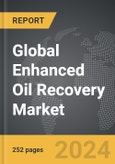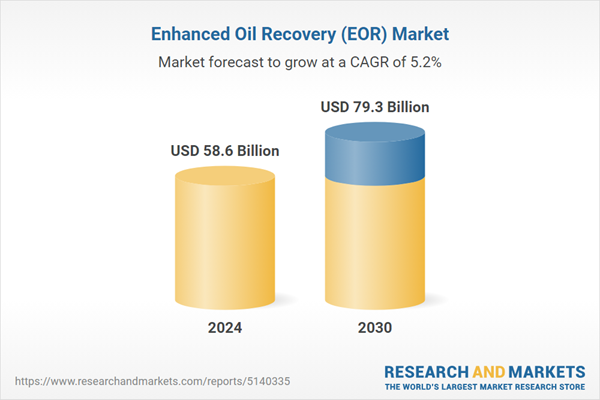The global market for Enhanced Oil Recovery (EOR) was valued at US$58.6 Billion in 2024 and is projected to reach US$79.3 Billion by 2030, growing at a CAGR of 5.2% from 2024 to 2030. This comprehensive report provides an in-depth analysis of market trends, drivers, and forecasts, helping you make informed business decisions. The report includes the most recent global tariff developments and how they impact the Enhanced Oil Recovery (EOR) market.
Segments: Technology (Thermal, Gas, Chemical, Other Technologies); End-Use (On-Shore, Off-Shore).
Geographic Regions/Countries: World; United States; Canada; Japan; China; Europe (France; Germany; Italy; United Kingdom; and Rest of Europe); Asia-Pacific; Rest of World.
The analysts continuously track trade developments worldwide, drawing insights from leading global economists and over 200 industry and policy institutions, including think tanks, trade organizations, and national economic advisory bodies. This intelligence is integrated into forecasting models to provide timely, data-driven analysis of emerging risks and opportunities.
Global Enhanced Oil Recovery (EOR) Market - Key Trends & Drivers Summarized
What Is Enhanced Oil Recovery And Why Is It Vital For The Oil & Gas Industry?
Enhanced Oil Recovery (EOR) is a set of techniques used to increase the amount of crude oil that can be extracted from an oilfield after primary and secondary recovery methods have been exhausted. EOR is vital for the oil and gas industry as it enables operators to maximize the recovery of hydrocarbons from mature fields, which are becoming increasingly prevalent as easily accessible oil reserves dwindle. By injecting substances such as water, gas, or chemicals into reservoirs, EOR techniques help to alter the properties of the oil and improve its flow, enhancing the extraction process. The primary types of EOR include thermal recovery, gas injection, and chemical injection, each tailored to specific reservoir conditions. As global energy demand continues to rise and oil companies face pressure to optimize production from existing assets, EOR is becoming an indispensable tool for prolonging the life of oilfields and improving overall recovery rates.What Technological Innovations Are Driving The Enhanced Oil Recovery Market?
Technological innovations are significantly driving the Enhanced Oil Recovery (EOR) market by improving the efficiency, cost-effectiveness, and environmental impact of EOR methods. Advances in chemical EOR techniques, such as the development of new surfactants, polymers, and nanoparticles, are enhancing oil displacement and reducing the amount of chemicals required, thus lowering operational costs. In gas injection EOR, innovations such as the use of carbon dioxide (CO2) and nitrogen gas are proving to be more effective in certain reservoir conditions, while also offering benefits in terms of carbon sequestration and reducing greenhouse gas emissions. Additionally, digital technologies, such as reservoir simulation models, AI, and machine learning, are being used to optimize EOR processes by providing better reservoir characterization and predicting the behavior of injected substances. These technological advancements are critical in addressing the challenges associated with EOR, including the need for more sustainable and economically viable recovery methods.How Are Market Dynamics And Regional Trends Impacting The EOR Market?
Market dynamics, such as fluctuating oil prices, the decline in production from mature fields, and the shift towards unconventional resources, are significantly impacting the EOR market. In regions like North America, where shale oil production is prominent, there is a growing need for EOR techniques to optimize production and extend the life of wells. In the Middle East, where large, mature oilfields dominate, the focus is on deploying advanced EOR methods to maintain production levels and maximize reserves. The market is also being influenced by regulatory and environmental factors, with an increasing emphasis on CO2-based EOR for its dual benefits of enhanced oil recovery and carbon capture and storage (CCS). These regional trends and market dynamics underscore the strategic importance of EOR in ensuring long-term energy security and sustainability.What Factors Are Driving The Growth Of The Enhanced Oil Recovery (EOR) Market?
The growth in the Enhanced Oil Recovery (EOR) market is driven by several factors, including the rising demand for energy, the depletion of easily accessible oil reserves, and technological advancements in EOR methods. A key driver is the increasing focus on maximizing recovery from mature and declining oilfields, which requires the implementation of advanced EOR techniques. The development of unconventional oil resources, such as shale and tight oil, is also driving demand for EOR solutions that can enhance production efficiency. Additionally, the growing emphasis on carbon capture and storage (CCS) technologies is supporting the use of CO2-EOR methods, which offer both enhanced recovery and environmental benefits. The need for sustainable and cost-effective oil production methods, coupled with continuous innovations in chemical, thermal, and gas injection techniques, is further propelling the EOR market. These factors, combined with favorable regulatory support and government incentives for enhanced recovery methods, are driving the global EOR market forward.Report Scope
The report analyzes the Enhanced Oil Recovery (EOR) market, presented in terms of units. The analysis covers the key segments and geographic regions outlined below.Segments: Technology (Thermal, Gas, Chemical, Other Technologies); End-Use (On-Shore, Off-Shore).
Geographic Regions/Countries: World; United States; Canada; Japan; China; Europe (France; Germany; Italy; United Kingdom; and Rest of Europe); Asia-Pacific; Rest of World.
Key Insights:
- Market Growth: Understand the significant growth trajectory of the Thermal segment, which is expected to reach US$35.4 Billion by 2030 with a CAGR of a 5.0%. The Gas segment is also set to grow at 5.9% CAGR over the analysis period.
- Regional Analysis: Gain insights into the U.S. market, valued at $16.0 Billion in 2024, and China, forecasted to grow at an impressive 5.0% CAGR to reach $12.5 Billion by 2030. Discover growth trends in other key regions, including Japan, Canada, Germany, and the Asia-Pacific.
Why You Should Buy This Report:
- Detailed Market Analysis: Access a thorough analysis of the Global Enhanced Oil Recovery (EOR) Market, covering all major geographic regions and market segments.
- Competitive Insights: Get an overview of the competitive landscape, including the market presence of major players across different geographies.
- Future Trends and Drivers: Understand the key trends and drivers shaping the future of the Global Enhanced Oil Recovery (EOR) Market.
- Actionable Insights: Benefit from actionable insights that can help you identify new revenue opportunities and make strategic business decisions.
Key Questions Answered:
- How is the Global Enhanced Oil Recovery (EOR) Market expected to evolve by 2030?
- What are the main drivers and restraints affecting the market?
- Which market segments will grow the most over the forecast period?
- How will market shares for different regions and segments change by 2030?
- Who are the leading players in the market, and what are their prospects?
Report Features:
- Comprehensive Market Data: Independent analysis of annual sales and market forecasts in US$ Million from 2024 to 2030.
- In-Depth Regional Analysis: Detailed insights into key markets, including the U.S., China, Japan, Canada, Europe, Asia-Pacific, Latin America, Middle East, and Africa.
- Company Profiles: Coverage of players such as Anadarko Petroleum Corporation, Babcock & Wilcox Enterprises, Inc., Babcock Power Inc., BP PLC, Cenovus Energy, Inc. and more.
- Complimentary Updates: Receive free report updates for one year to keep you informed of the latest market developments.
Some of the 54 companies featured in this Enhanced Oil Recovery (EOR) market report include:
- Anadarko Petroleum Corporation
- Babcock & Wilcox Enterprises, Inc.
- Babcock Power Inc.
- BP PLC
- Cenovus Energy, Inc.
- Chevron Corporation
- Clayton Industries
- ConocoPhillips Company
- EN-Fab Inc.
- Exxon Mobil Corporation
- Hamon Deltak, Inc.
- Lukoil Oil Company
- Nooter/Eriksen, Inc.
- Petronas Chemicals Group Berhad
- Premier Energy Inc.
- Royal Dutch Shell PLC
- Statoil ASA
Tariff Impact Analysis: Key Insights for 2025
Global tariff negotiations across 180+ countries are reshaping supply chains, costs, and competitiveness. This report reflects the latest developments as of April 2025 and incorporates forward-looking insights into the market outlook.The analysts continuously track trade developments worldwide, drawing insights from leading global economists and over 200 industry and policy institutions, including think tanks, trade organizations, and national economic advisory bodies. This intelligence is integrated into forecasting models to provide timely, data-driven analysis of emerging risks and opportunities.
What’s Included in This Edition:
- Tariff-adjusted market forecasts by region and segment
- Analysis of cost and supply chain implications by sourcing and trade exposure
- Strategic insights into geographic shifts
Buyers receive a free July 2025 update with:
- Finalized tariff impacts and new trade agreement effects
- Updated projections reflecting global sourcing and cost shifts
- Expanded country-specific coverage across the industry
Table of Contents
I. METHODOLOGYII. EXECUTIVE SUMMARY2. FOCUS ON SELECT PLAYERSIII. MARKET ANALYSISIV. COMPETITION
1. MARKET OVERVIEW
3. MARKET TRENDS & DRIVERS
4. GLOBAL MARKET PERSPECTIVE
UNITED STATES
CANADA
JAPAN
CHINA
EUROPE
FRANCE
GERMANY
ITALY
UNITED KINGDOM
REST OF EUROPE
ASIA-PACIFIC
REST OF WORLD
Companies Mentioned (Partial List)
A selection of companies mentioned in this report includes, but is not limited to:
- Anadarko Petroleum Corporation
- Babcock & Wilcox Enterprises, Inc.
- Babcock Power Inc.
- BP PLC
- Cenovus Energy, Inc.
- Chevron Corporation
- Clayton Industries
- ConocoPhillips Company
- EN-Fab Inc.
- Exxon Mobil Corporation
- Hamon Deltak, Inc.
- Lukoil Oil Company
- Nooter/Eriksen, Inc.
- Petronas Chemicals Group Berhad
- Premier Energy Inc.
- Royal Dutch Shell PLC
- Statoil ASA
Table Information
| Report Attribute | Details |
|---|---|
| No. of Pages | 252 |
| Published | April 2025 |
| Forecast Period | 2024 - 2030 |
| Estimated Market Value ( USD | $ 58.6 Billion |
| Forecasted Market Value ( USD | $ 79.3 Billion |
| Compound Annual Growth Rate | 5.2% |
| Regions Covered | Global |









